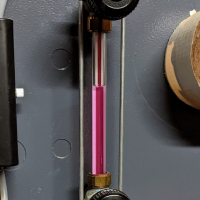Welcome! Here are the website rules, as well as some tips for using this forum.
Need to contact us? Visit https://heatinghelp.com/contact-us/.
Click here to Find a Contractor in your area.
Radiator Safety?
Options
jmob77
Member Posts: 39
In light of a recent tragic event in NYC, I have some questions regarding radiator safety. This incident is still under investigation, but in the media coverage, mention has been made of a faulty "valve"; not sure whether they are referring to the shutoff valve or to the air vent, which it seems people often mistakenly refer to as a valve.
My main point is, as a homeowner, what are some of the things to watch out for with regard to radiator safety and maintenance on a one-pipe steam system?
As far as vents go, all of my (Gorton) vents on my radiators appear to be working properly; I removed each one about a month ago to inspect them. They appeared free of any visible scale, the closing mechanism seemed to move freely within the vent housing (i.e. you can hear it jiggle back and forth when inverting the valve), and I was able to easily blow air through them. My convector-style radiators are recessed and have no shutoff valves.
Some of the radiators do produce a bit of sound, I believe this is partially caused by the fact that one of my two mains is hidden within a renovation by the previous owner and is probably in need of better venting; a project I was unable to achieve in warmer weather.
Any input on this issue would be greatly appreciated; hoping I'm doing everything possible to keep everyone in the house warm, and safe!
John
Brooklyn, NY
My main point is, as a homeowner, what are some of the things to watch out for with regard to radiator safety and maintenance on a one-pipe steam system?
As far as vents go, all of my (Gorton) vents on my radiators appear to be working properly; I removed each one about a month ago to inspect them. They appeared free of any visible scale, the closing mechanism seemed to move freely within the vent housing (i.e. you can hear it jiggle back and forth when inverting the valve), and I was able to easily blow air through them. My convector-style radiators are recessed and have no shutoff valves.
Some of the radiators do produce a bit of sound, I believe this is partially caused by the fact that one of my two mains is hidden within a renovation by the previous owner and is probably in need of better venting; a project I was unable to achieve in warmer weather.
Any input on this issue would be greatly appreciated; hoping I'm doing everything possible to keep everyone in the house warm, and safe!
John
Brooklyn, NY
0
Comments
-
Periodic checks and maintenance is the best advice, I think.
Make sure the boiler pressure and controls work like they are suppose to.
Make sure any leaking valves/valve stems and even steam pipes are repaired.
Make sure the rads themselves don't have a leak, I've seem people put a small container under a rad to collect the leaking condensate.
Make sure the vents fit snugly into the radiator tappings. If they don't, tap the radiator for a 1/4" to 1/8" brass bushing so that the vent screws in properly.
Make sure anyone in the household knows where the power shut off to the boiler is located and how to shut the power down, if required. If your tstat has a "System Off" button, that may be the safest option to power down the boiler.
Make sure everyone understands when it might be necessary to just leave the premises and who to call if they have any concern or have to leave.
Just some ideas.0 -
yeah, i'm with Fred..maintenance on the boiler every year is probably your best guard against issues.gwgillplumbingandheating.com
Serving Cleveland's eastern suburbs from Cleveland Heights down to Cuyahoga Falls.0 -
Neglect of maintenance could very well lead to a dangerous situation. Dirt could clog pig tails and low water cutoffs leading to excessive higher pressure or no account of the water line.DL Mechanical LLC Heating, Cooling and Plumbing 732-266-5386
NJ Master HVACR Lic# 4630
Specializing in Steam Heating, Serving the residents of New Jersey
https://heatinghelp.com/find-a-contractor/detail/dl-mechanical-llc
https://m.facebook.com/DL-Mechanical-LLC-315309995326627/?ref=content_filter
I cannot force people to spend money, I can only suggest how to spend it wisely.......0 -
Making sure that the main venting is adequate will take a lot of the venting load of the radiator vents. Their constipated little openings were never designed to handle more than the air in the takeoff from the main to the radiator.
Timing the steam arrival from boiler boiling to radiator will give you a clue as to whether there is a lack of venting requiring extra fuel to be burned simply to push the air out, before heating commences.--NBC0 -
As with all things in life, maintenance matters.Retired and loving it.0
-
Maintenance and education. The homeowner/customer has to realize that steam heat is a living, breathing thing. It needs attention even more than it's 'annual maintenance'.
I spend alot of time with my steam customers, explaining every aspect of the system, what to look for that can become dangerous etc.
Steam is not the set-it-and-forget-it system.There was an error rendering this rich post.
0 -
You mention that a couple of recessed rads do not have shut off valves. I'm guessing there was not enough room to install them in the recess. If at all possible, try to install shut off valves on the branches feeding those rads. If there is room in the basement or even behind an adjacent wall where you might be able to cut in a valve and put an access door afterwards to get to the valves, you would be doing something that is very proactive.
Not only will you be providing safety for your home and family, but you will be protecting yourself from a possible shut down that can become an emergency situation in the middle of the winter! That can be a very costly emergency.0 -
NO heating systems are set it and forget it, none of them.
All of them need maintenance. Even forced air furnaces should be inspected and cleaned at least once a season. Burners get dirty, pressure regulators drift, air intakes get clogged etc.
I cannot count the amount of times I've seen unbelievably disgusting filters pulled out of forced air systems because they were ignored.
A steam system is no different than any other heating system, it must be maintained.
A forced air furnace could in theory kill a family due to a cracked heat exchanger and as far as I know, cracked heat exchangers aren't that uncommon.
For a steam system as with all other systems ensuring the burner is working properly, the flue is clear and there is plenty of fresh air for combustion is important. The pigtail should be cleaned and the LWCO and Pressuretrol should be tested.
All vents on radiators should work well and should be on the radiators a good 3 or 4 turns and fairly snug. If the threads are questionable they should be chased with a tap or drilled out and enlarged to 1/4" and a bushing installed. There is never an excuse for a loose or poor fitting vent. All packing nuts should be snug and not leaking.
All of this is basic maintenance and very easy to do.
Single pipe quasi-vapor system. Typical operating pressure 0.14 - 0.43 oz. EcoSteam ES-20 Advanced Control for Residential Steam boilers. Rectorseal Steamaster water treatment0
Categories
- All Categories
- 85.7K THE MAIN WALL
- 3K A-C, Heat Pumps & Refrigeration
- 51 Biomass
- 423 Carbon Monoxide Awareness
- 71 Chimneys & Flues
- 1.9K Domestic Hot Water
- 5.2K Gas Heating
- 92 Geothermal
- 149 Indoor-Air Quality
- 3.2K Oil Heating
- 60 Pipe Deterioration
- 850 Plumbing
- 5.8K Radiant Heating
- 375 Solar
- 14.5K Strictly Steam
- 3.2K Thermostats and Controls
- 51 Water Quality
- 38 Industry Classes
- 55 Job Opportunities
- 18 Recall Announcements




